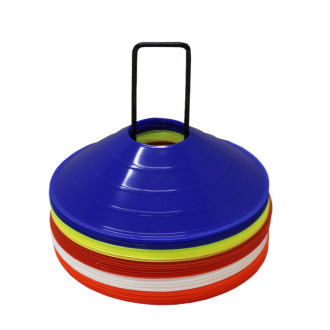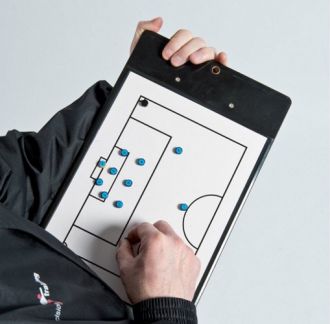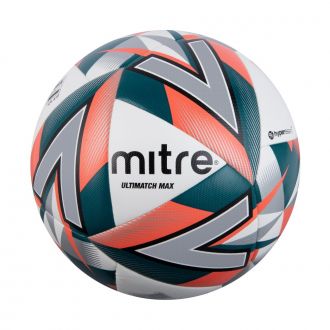How To Coach Toddler Soccer
Tim Wareing from TW Sports gives us the lowdown on how to coach football to Toddlers
Clubs are dropping their entry age while English Academy set ups are starting to look at children younger & younger through fear on missing out on the next 'big talent'. For those working with toddlers, or if you prefer, under 6's you need to remember the most important factor & that is fun. This is children's first introduction to football & the most important aspect is for them to fall in love with the game. As a coach you need to adapt, lose your inhibition & become an entertainer!
3 years into kicking off my football development programme I was unique. Not just as I welcomed children in from the age of 5 (most other clubs / organisations were 6-8 year old) but I then introduced a revolutionary way of introducing young children to football coaching from the age of 2. Call it vision or call it fluke but the programme simply came about from younger brothers & sisters being disappointed that they couldn't play football when they dropped their older brother or sister off to our Mini Soccer sessions.
With this in mind I started to plan sessions for younger children & called it 'Toddler Soccer'. My first port of call was Google to see what advice was out there to work with such young children. I didn't find very much. So I went about planning a programme using the first set of kids as guinea pigs to see what worked & what didn't.
Ronaldo & Messi vs Toy Story & Finding Nemo!
One thing that was obvious to me with children aged 7 & above that they were motivated with pro players...Messi, Ronaldo, Rooney & co. But children aged 2, 3 & 4...what would they be motivated in...who did they look up to? Well, with having children of my own I only had to look at what they watched on TV, who they talked about. I soon came to the conclusion that if I used familiar children's television programmes we would be on to a winner.
We have children as young as 2 dribbling the ball close to them so Dr. Evil Porkchop doesn't steal their ball. We have them dressing up with crazy cones for ears & heading the ball as Mr & Mrs Potato head. We have them checking their shoulders looking out for coach, mummy or daddy trying to steal their ball & the fun factor of them roaring like Rex the dinosaur! We have fun passing exercise of them being Nemo & knocking down the mini traffic cones...or should I say rocks at the bottom of the sea bed before Bruce the Shark catches them!
Over the past number of years I have written a book on the topic as I have received requests from all over the world regarding my programme. To date the book has sold in over 25 different countries! Below I will share with you some of my hints, tips & games for you to try out with your young kids!
How do I start?
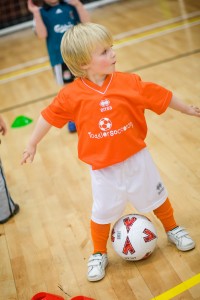
When working with a group, get the toddlers to sit in a circle. Ensure that adults kneel down with toddlers so that you are speaking to them at their level. Always start with introductions e.g. ‘I’m Coach Tim & this is Coach Ronnie’ as they may have forgotten your name or be a new member.
Relax & build a relationship with them. Ask what kind of week they have had. What did they do at nursery? Comment on new shoes or T-shirts. If they think that you are interested in their lives they will be more inclined to work with you.
Finally, do a simple listening game so that everyone gets ‘tuned in’. Do silly things such as getting them to put their hand behind their ear & tuning in to Coach Tim FM! Another idea is the ‘Stop, freeze’ game. Toddlers run about & then freeze when the whistle is blown.
Now introduce the game you are going to do. Keep instructions short & make sure everyone can hear & see you. Always ask if everyone understands & repeat if necessary.
Coaching Style.
It is best to be vocal. Tell the story so that each child can visualize what is happening. Use different tones to tell the story. Make each session an adventure!
To get the toddlers to interact, start a sentence but get them to finish it. When you are kneeling down & they are sitting on their ball listening, then begin the story. ‘Ok, we are in the jungle today & we are Diego & Dora. Our ball is the little monkey from Dora the Explorer…what’s his name?’ They reply ‘BOOTS!’ It is great to have the toddlers join in & give feedback, then you know that they are fully engaged. I once had nearly 50 passers-by stop to see what the heck was going on!
Always demonstrate. Make your language child-friendly & break skills right down. Don’t stand & demonstrate a skill such as a drag back to the toddlers as you would to ten year olds. Paint the picture instead. Ask them to imagine that the ball is a puppy & he wants to roll over & have his tummy tickled. Can we put our foot on him & roll him backwards?
Get a more able toddler to demonstrate a skill as this will encourage his peers to have a go when they see that someone of their own age can do it. Give lots of praise. Be vocal & use the ‘high five’!
Lose your inhibitions!
This is of prime importance. Forget about parents & passers-by watching you. Get down to the toddlers level. Kneel down to speak to them, use funny voices & pull funny faces. Bring these sessions to life! Remember, the coach who leads the programme will determine how successful it is.
Try to get inside the toddler’s head & use as a starting point what they like to see, hear & do. Those who have children should find easy as they will be up to date with the cartoons they like to watch. But do not rule out young coaches. I find that they can relate well to kids.
An example of a silly thing to do with the toddlers is to turn a small traffic cone upside down & place a ball on top of it. Then tell the toddlers ‘Well done! Now have a big ice cream.’ Add to the fun by making funny noises while squirting pretend strawberry sauce on the top of the ‘ice cream’! We also put discs (small cones) on top of our ears to look silly & pretend to have supersonic hearing!
My session notes…
This is a great warm up game & so simple for young children to follow.
Body Parts
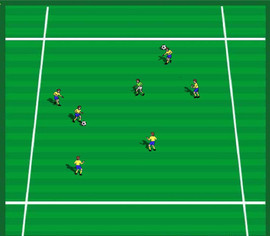
Emphasis
Session on ball familiarity.
Set-Up
Use cones to mark out a 25 x 25 yard area. All players have a ball & stay inside the area.
Objectives
Players start by dribbling a mini football around the area. The coach will call out different body parts. The player must respond by stopping the ball with that body part, e.g. right foot, ear, chest, knee, etc.
Progressions
- Add extra fun by getting them do 'disco dance' like mum & dad by giving quick commands like, 'right knee, left knee, right knee, left knee, right foot, left foot,'. They could also clap their hands at the same time.
- When they get their chest on the ball get them to put their right arm out & pretend to fly like Super Man!
Coaching
- Keep the ball close to your feet, take light touches.
- Keep the head up & look for space.
You can progress the session to a fun game featuring their favourite Disney movie or cartoon characters!
Roary The Racing Car
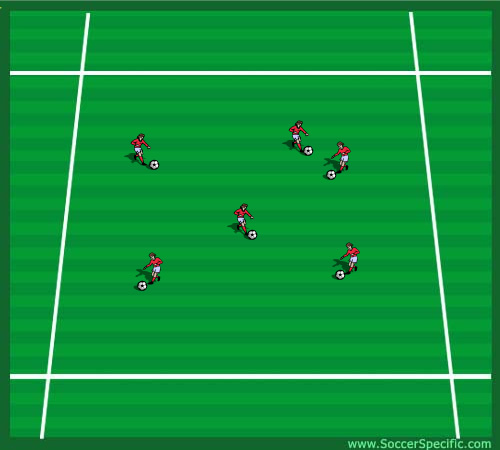
Emphasis
Dribbling, skills & turns.
Set-Up
Session takes place in a 20 x 20 yard grid. All players have a ball each.
Objectives
All players are racing car drivers & the ball is Roary the Racing Car or another character from the show.
Encourage players to 'drive' (dribble) around the race track (grid). They must keep their race car (ball) under control. Encourage use of both feet.
Introduce different skills & turns. Players perform toe taps to start their engines. To drive around the 'chicane' they perform the scissors. To reverse they perform the drag back.
Also add in fun extras that toddlers love. If anyone is in their way get them to beep their horn. Or ask them to put their lights on when it is getting dark, simply make a small twist with your hand & a funny noise to switch them on. Or if it rains they must put their wind screen wipers on waving their arms.
Use your imagination & have some fun!
Progressions
- Introduce mini gates by using cones. Players must dribble through all the different mini gates.
- Use football cones for traffic lights. Red = stop, orange = get ready / start engine, Green = GO! Get players to get their heads up & watch the signals.
- Introduce different speeds like granny speed (slow), mummy & daddy speed (fast) & Roary the Racing Car speed (super fast).
- Add more traffic signals.
Coaching
- Good dribbling skills.
- Use of both feet.
- Keep head up.
- Skills.
Yours in sport
Tim Wareing
Director & Head Coach
TWSports.Org Mini Soccer Centres

